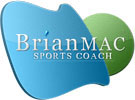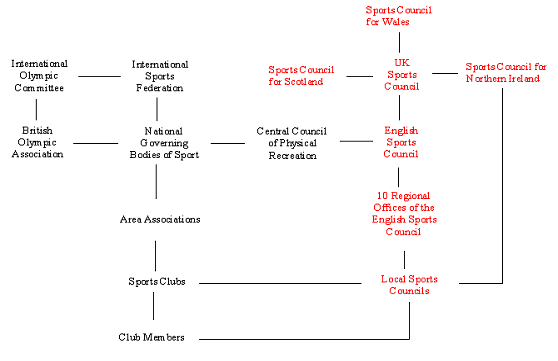

Structure of British Sport
In Britain, clubs, groups and individuals have developed their particular sport in their own way, and their governing body protecting them has meant that we do not have a national sports policy. The Sports Council, founded in 1972, was an attempt to develop a national sports policy.
Structure of Sport
The following diagram (Beashel 1997)[1] gives a pictorial view of the structure of sport in Britain and the associated governing bodies.

Roles
Some of the roles and responsibilities of the various bodies are as follows:
- International Olympic Committee - Manage all Olympic matters.
- International Sports Federation - Manage their sport worldwide.
- British Olympic Association - Promote the Olympics.
- National Governing Bodies of Sport - support Sports
Clubs.
- Promote and run the sport.
- Organise competitions and events.
- Select teams at all levels.
- Set coaching standards.
- Arrange coaching and training.
- Organise award schemes.
- Enforce rules and regulations.
- Central Council of Physical Recreation - Represent their governing bodies.
- UK Sports Councils - Manage Sport in the UK and International affairs.
- Sports councils for Wales, Scotland, England and Northern Ireland - Try to coordinate all the different organisations involved in developing sport in their country.
Sports Councils
The aims of each Sports Council are to:
- Increase participation in sports and physical recreation.
- Increase the quantity and quality of sports facilities.
- Raise standards of performance.
- Provide information for and about sport.
The Sports Council:
- Provide grants to the national governing bodies to run programs to meet the Sports Council's aims.
- Provide grants for new facilities.
- Run campaigns to encourage participation.
- Run national sports centres.
- Responsible for providing the money for sport from the National Lottery.
- Produce strategy documents to explain how they will achieve their aims in the future.
In 1993, the Sports Council published 'Sport in the Nineties: New Horizons', which describes their vision of everyone being able to participate and reach their full potential in sport. To turn this vision into practice, there are aims based on two key principles: the sports development continuum and sports equity.
Sports Development Continuum
The aim is to offer everyone the chance to improve their skills and participate in sports and physical recreation. There are four stages:
- Foundation - Young people are taught P.E. and learn basic sports skills.
- Participation - Everyone can take part in the sports of their choice.
- Performance - Those interested have the chance to improve their sporting ability.
- Excellence - Talented performers can develop sporting excellence.
Sports Equity
The aim is to protect sport and participants from harmful influences. It is about:
- Fairness in sport.
- Enabling all to take part.
- Recognising problems and acting.
- Changing the culture of sport so that age, race, gender or ability does not stop anyone from taking part.
The emphasis is on:
- Help for young people.
- The support of excellence.
- The use of National Lottery funds to improve facilities and support top participants.
References
- BEASHEL, P and TAYLOR, J (1997) Providing for Sport. In: BEASHEL, P and TAYLOR, J, The World of Sport Examined. Croatia: Thomas Nelson and Sons, p. 164
Page Reference
If you quote information from this page in your work, then the reference for this page is:
- MACKENZIE, B. (2001) Structure of British Sport [WWW] Available from: https://www.brianmac.co.uk/structure.htm [Accessed